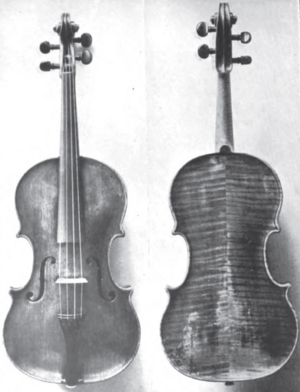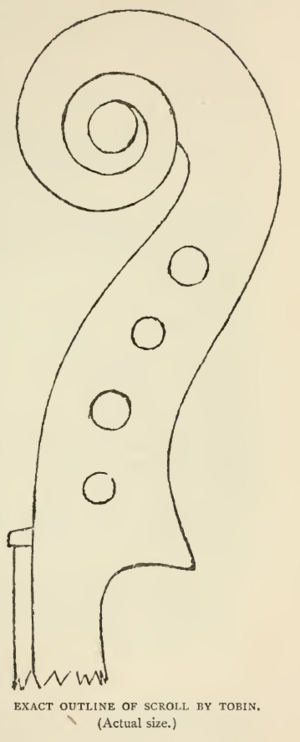Richard Tobin (luthier) facts for kids
Quick facts for kids
Richard Tobin
|
|
|---|---|
| Risteárd Tóibín | |

Violin by Tobin, published in 1920
|
|
| Born | 1766 Dublin, Ireland
|
| Died | December 1847 (aged 80–81) Middlesex, London
|
| Nationality | Irish |
| Education | Thomas Perry |
| Known for |
|
|
Notable work
|
|
| Style |
|
| Movement |
|
| Spouse(s) | Elizabeth Daley |
Richard Tobin (born in 1766, died in 1847) was an amazing Irish instrument maker. He created beautiful violins, violas, cellos, and even tiny violins called pochettes. A person who makes or repairs stringed instruments like these is called a luthier.
Even though he made incredible instruments, his name wasn't always on them. His work was often sold under the names of the shops or people he worked for. Experts have called him a "genius" because of his skill. He was also famous for carving the decorative "scrolls" at the top of the instruments. People even said his scrolls were as good as those made by the famous Italian maker, Antonio Stradivari!
Contents
Early Life and Learning to Make Instruments
Richard Tobin was born near Dublin, Ireland, around 1766. Some historians thought he might have been born in Waterford because of where some of his early instruments were found. However, Tobin himself said he was born a few miles outside of Dublin. Records from the UK National Archives confirm his birth year as 1766.
It's said that Richard fell in love with the violin when he was a little boy. He heard it played at parties and gatherings. He started making his own violins from old boxes and pieces of wood he found.
When he was about 14, Tobin made a pretty good violin from a block of willow wood. He sold it to a neighbor who played the fiddle. This neighbor showed the instrument to Thomas Perry, a very famous luthier in Dublin. Perry was so impressed by the young boy's work that he decided to take Tobin on as his apprentice. An apprentice is someone who learns a skill or trade by working with an experienced master.
We don't know much about Tobin's parents. One of his violins from his time with Perry was marked 'Richard Tobin Junior'. This might mean his father was also named Richard Tobin. Or, it could just mean he was an apprentice at the time.
Richard Tobin's Career as a Luthier
Starting Out: 1783–1810
Richard Tobin learned his craft from Thomas Perry in Dublin, probably between 1783 and 1790. After his apprenticeship, he worked for a short time in Cork for another luthier named Bartholomew Murphy. He was listed as working on Patrick Street in Cork in 1805.
Later, he started working on his own. He then moved to London around 1810. He made this move after getting advice from Vincenzo Panormo, another famous luthier who had also worked for Thomas Perry.
Working in London: 1810–1847
Tobin's first known work in London dates back to 1810. It seems he worked for Henry Lockey Hill at first. A violin from 1817 even has a signature inside that says 'R. Tobin for L. Hill'.
By 1823, Tobin had his own workshop at 9 West Street in Soho, London. His son, George, also became a violin maker and worked with his father from about 1823 to 1830. Like his father, George's work is hard to identify because he usually worked for other violin makers and dealers, so his instruments weren't often labeled with his own name.
How Richard Tobin Made Instruments
Richard Tobin was known for his very precise and detailed work. He often copied the styles of famous Italian makers like Amati or Stradivari. His violins are known for having a rich and soft sound.
The varnish on Tobin's instruments can look different from one to another. This is because he sometimes sold instruments without varnish. Other times, he used the varnish provided by the shop he was working for.
Tobin was one of the best scroll carvers ever. You can often spot his unique scroll work on instruments made by other famous makers like John Betts, Thomas Dodd, and Henry Lockey Hill. His scrolls were so good that a drawing of one was even included in a book called British Violin Makers in 1904. Even though his work was very detailed, he was also very fast. He could finish carving a scroll in less than two hours!
Sometimes, he would sign his instruments inside or brand them with his name. But it's very rare to find an original label with Richard Tobin's name on it.
|
|||||||||||||||||||||||||||||||||||||||||||||||||||||||||||||||||||||||||||||||||||||||||||||||||||||||||||||||||||||||||||||||||||||||||||||||||||||||||||||||||||||||||||||||||||||||||||||||||||||||||||||||||||||||||||||||||||||||||||||||||||||||||||||||||||||||||||||||||||||||||||||||||||||||||||||||||||||||||||||||||||||||||||||||||||||||||||||||||||||||||||||||||||||||||||||||||||||||||||||||||||||||||||||||||||||||||||||||||||||||||||||||||||||||||||||||||||||||||||||||||||||||||||||||||||||||||||||||||||
|
|||||||||||||||||||||||||||||||||||||||||||||||||||||||||||||||||||||||||||||||||||||||||||||||||||||||||||||||||||||||||||||||||||||||||||||||||||||||||||||||||||||||||||||||||||||||||||||||||||||||||||||||||||||||||||||||||||||||||||||||||||||||||||||||||||||||||||||||||||||||||||||||||||||||||||||||||||||||||||||||||||||||||||||||||||||||||||||||||||||||||||||||||||||||||||||||||||||||||||||||||||||||||||||||||||||||||||||||||||||||||||||||||||||||||||||||||||||||||||||||||||||||||||||||||||||||||||||||||||
Richard Tobin's Family Life
Richard Tobin married an Irish woman named Elizabeth Daley. They had at least four children: George, John, Elizabeth, and Esther.
In 1816, two of his children, John and Elizabeth, were baptized in London. The family lived on Leonard Street in Shoreditch. Sadly, his younger son, John, passed away when he was only six years old in 1818.
By 1841, Tobin was living with his wife and two daughters in a part of London called St Giles. This area was known for being quite poor at the time. It's possible Tobin ended up there because of his connection to Vincenzo Panormo, who also lived in that area. Even today, the Soho area of London is famous for its violin makers and sellers.
In his later years, Tobin faced some challenges and found it hard to support himself as a luthier. He passed away in December 1847 and was buried in a simple grave in St Leonard's, Shoreditch.
Instruments You Can Still Find Today
We don't know exactly how many instruments Richard Tobin made in his lifetime. Some of them still exist today and are sometimes sold at auctions. Others are kept in special collections or museums. Many more are likely out there, but they don't have his name on them.
For example, one of his violins, made around 1820, is now part of The Harrison-Frank Family Foundation collection. It is currently played by violinist Emma Pantel. One of Tobin's cellos was even used to record music for some of the very first movies ever made! A small violin called a pochette, made by Tobin around 1800, is now kept at the National Music Museum in Vermillion, South Dakota.
Here are some of his notable instruments:
Violins
- 1789: Made in Dublin, labeled 'Made by Thos. Perry, 6 Anglesea Street, Dublin, No. 533, 1789', but also marked inside with 'Richard Tobin Junior'.
- Around 1800: Made in Waterford, labeled 'Made by Richard Tobin, Mus. Instr. Maker, Waterford'.
- Around 1805: Made in Cork, branded 'TOBIN/CORK' on the outside.
- Around 1820: Made in London, now part of The Harrison-Frank Family Foundation collection, played by Emma Pantel.
Violas
- Around 1820: Made in London, stamped inside 'TOBIN, LONDON'.
Cellos
- 1820: Made in London, used to record music for early movies.
Pochettes
- Around 1800: Part of the National Music Museum collection in Vermillion, South Dakota.
Images for kids



